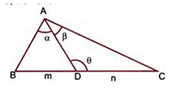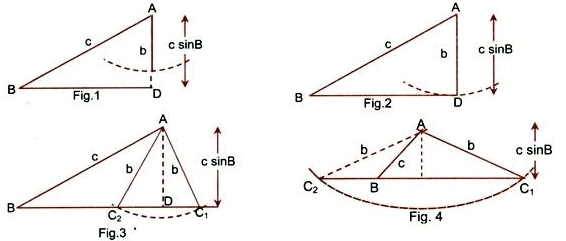JEE Exam > JEE Notes > Mock Tests for JEE Main and Advanced 2026 > Revision Notes - Solution of Triangles
Solution of Triangles Revision Notes | Mock Tests for JEE Main and Advanced 2026 PDF Download
- Sine rule: Sides of a triangle are proportional to the sine of the angles opposite to them. So, in ΔABC,
sin A/a = sin B/b = sin C/c = 2Δ/abc.
This may also be written as (a/sin A) = (b/sin B) = (c/sin C) - Cosine rule: In any ΔABC,
cos A = (b2 + c2 – a2) /2bc
cos B = (a2 + c2 – b2)/2ac
cos C = (a2 + b2 - c2)/2ab - Trigonometric ratios of half-angles:
sin A/2 = √[(s-b)(s-c)/bc]
sin B/2 = √[(s-c) (s-a)/ac]
sin C/2 = √[(s-a) (s-b)/ab]
cos A/2 = √s(s - a)/bc
cos B/2 = √s(s - b)/ac
cos C/2 = √s(s - c)/ab
tan A/2 = √[(s - b) (s - c)/s(s - a)]
tan B/2 = √[(s - c) (s - a)/s(s - b)]
tan C/2 = √[(s - a) (s - b)/s(s - c)] - Projection rule: In any ΔABC,
a = b cos C + c cos B
b = c cos A + a cos C
c = a cos B + b cos A - Area of a triangle
If Δ denotes the area of the triangle ABC, then it can be calculated in any of the following forms:
Δ = 1/2 bc sin A = 1/2 ca sin B = 1/2 ab sin C
Δ = √s(s - a)(s – b)(s - c)
Δ = 1/2. (a2 sin B sin C)/ sin(B + C)
= 1/2. (b2 sin C sin A)/ sin (C + A)
= 1/2. (c2 sin A sin B)/ sin (A + B) - Semi-perimeter of the triangle
If S denotes the perimeter of the triangle ABC, then s = (a + b + c)/2 - Napier’s analogy
In any ΔABC,
tan [(B – C)/2] = (b – c)/(b + c) cot A/2
tan [(C – A) /2] = (c – a)/(c + a) cot B/2
tan [(A – B) /2] = (a – b)/(a + b) cot C/2 - m-n theorem
Consider a triangle ABC where D is a point on side BC such that it divides the side BC in the ratio m: n, then as shown in the figure, the following results hold good: (m + n) cot θ = m cot α – n cot ß.
(m + n) cot θ = m cot α – n cot ß.
(m + n) cot θ = n cot B – m cot C. - Apollonius theorem
In a triangle ABC, if AD is the median through A, then
AB2 + AC2 = 2(AD2 + BD2). - If the three sides say a, b and c of a triangle are given, then angle A is obtained with the help of the formula
tan A/2 = √(s - b) (s - c) / s(s - a) or cos A = b2 + c2 - a2 / 2bc.
Angles B and C can also be obtained in the same way. - If two sides b and c and the included angle A are given, then
tan (B – C) /2 = (b – c)/ (b + c) cot A/2
This gives the value of (B- C)/2.
Hence, using (B + C)/2 = 90o - A/2 along with the last equation both B and C can be evaluated. Now, the sides can be evaluated using the formula
a = b sin A/sin B or a2 = b2 + c2 – 2bc cosA. - If two sides b and c and the angle B (opposite to side b) are given, then using the following results, we can easily obtain the remaining elements
sin C = c/b sinB, A = 180o – (B + C) and b = b sin A/sinB - Some of the important points which must be remembered include:
1. b < c sin B, there is no triangle possible (Fig. 1)
2. If b = c sin B and B is an acute angle, then only one triangle is possible (Fig. 2)
3. If c sin B < b < c and B is an acute angle, then there are two values of angle C (Fig. 3).
4. If c < b and B is an acute angle, then there is only one triangle (Fig. 4).
The document Solution of Triangles Revision Notes | Mock Tests for JEE Main and Advanced 2026 is a part of the JEE Course Mock Tests for JEE Main and Advanced 2026.
All you need of JEE at this link: JEE
|
357 docs|100 tests
|
FAQs on Solution of Triangles Revision Notes - Mock Tests for JEE Main and Advanced 2026
| 1. How do I solve a triangle using the given article's solution of triangles method? |  |
Ans. To solve a triangle using the given article's method, follow these steps:
1. Identify the given information: angles and sides of the triangle.
2. Determine which trigonometric ratio (sine, cosine, or tangent) to use based on the given information.
3. Apply the appropriate trigonometric ratio to find the missing angles or sides.
4. Repeat the process if necessary until all the angles and sides of the triangle are known.
5. Verify your solution by checking if the sum of all angles equals 180 degrees and if the triangle satisfies the triangle inequality theorem.
| 2. Can I solve a triangle with only two angles given? |  |
Ans. No, it is not possible to solve a triangle with only two angles given. In order to fully solve a triangle, you need to know either three sides or two sides and the included angle, or two angles and the included side. This principle is based on the fact that the sum of the angles in a triangle is always 180 degrees. Without sufficient information, it is not possible to determine the lengths of the sides or the values of the angles accurately.
| 3. Are there any special cases in solving triangles? |  |
Ans. Yes, there are special cases in solving triangles. Two commonly encountered special cases are the right-angled triangle and the equilateral triangle.
- In a right-angled triangle, one of the angles is 90 degrees. This allows for the use of special trigonometric ratios such as sine, cosine, and tangent.
- In an equilateral triangle, all three angles are equal to 60 degrees, and all three sides are equal in length. This symmetry simplifies the calculations and allows for the use of special trigonometric ratios.
| 4. Can I use the solution of triangles method to solve any type of triangle? |  |
Ans. Yes, the solution of triangles method can be used to solve any type of triangle, including acute, obtuse, and right-angled triangles. The method is based on trigonometric ratios, which are applicable to all types of triangles. However, it is important to ensure that you have sufficient information (angles or sides) to apply the trigonometric ratios accurately. Otherwise, the triangle may not be solvable.
| 5. What is the significance of verifying the solution in solving triangles? |  |
Ans. Verifying the solution is important in solving triangles to ensure the accuracy of the calculations and to confirm that the triangle is valid. By checking if the sum of all angles equals 180 degrees, you can confirm that your solution is consistent with the rules of geometry. Additionally, verifying the solution helps identify any errors or inconsistencies in the calculations, allowing you to correct them and arrive at the correct solution.
Related Searches

















